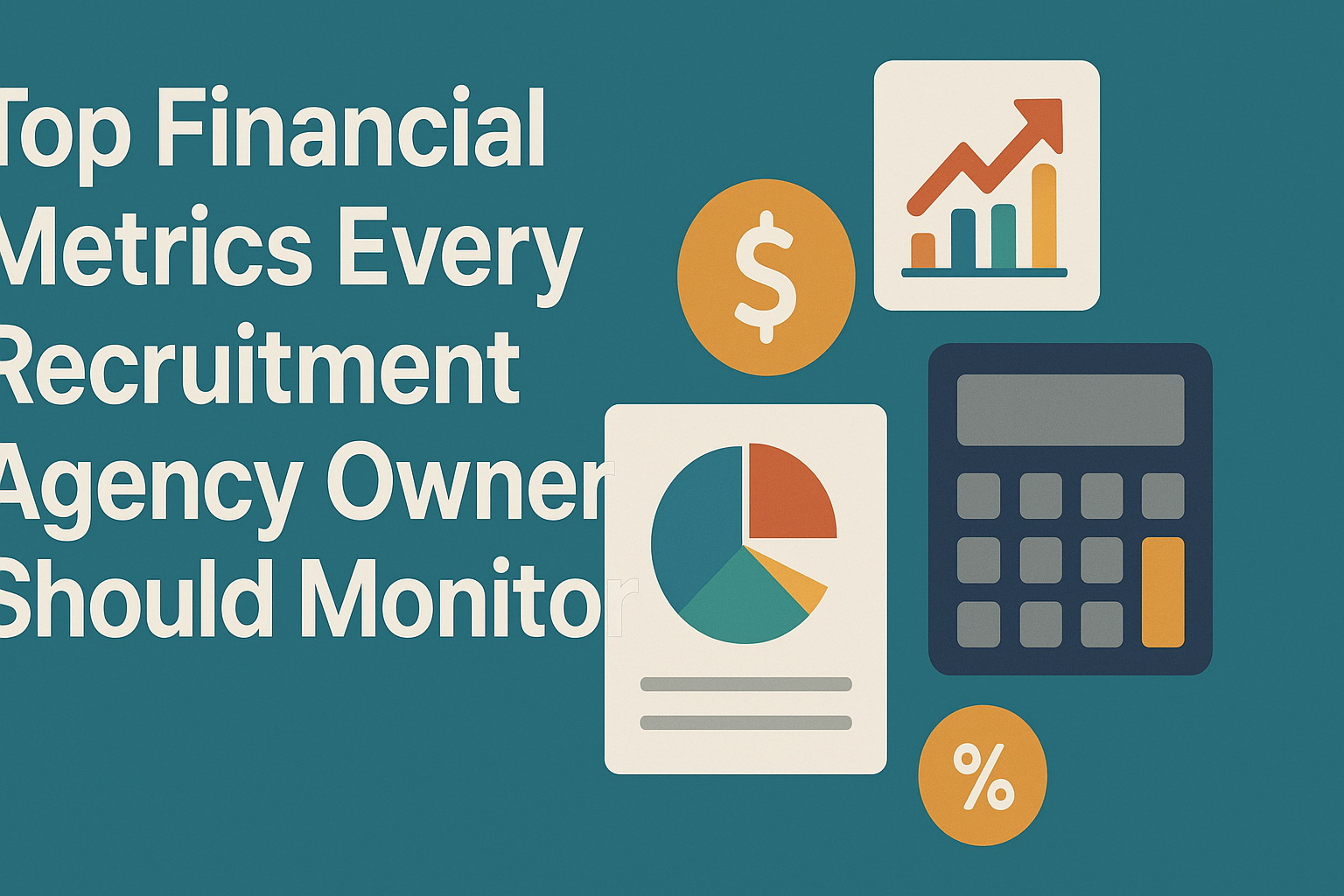By
Beatriz Jardim
July 24, 2025

Running a successful recruitment agency requires more than just connecting clients with candidates. To ensure long-term growth and profitability, agency owners must keep a close eye on their financial performance. Tracking key financial metrics helps you understand where your business stands, identify areas for improvement, and make informed decisions to stay ahead of the competition.
In this blog post, we’ll cover the top financial metrics every recruitment agency owner should monitor and how they can help improve your agency’s financial health.
Gross profit per placement measures the profit generated from each candidate placement after deducting direct costs like salaries or contractor payments.
Formula:
Gross Profit Per Placement = (Placement Fee - Direct Costs) ÷ Number of Placements
This metric helps you evaluate the profitability of your placements. If gross profit per placement is low, it might indicate that fees are too low or costs are too high.
Review your pricing strategy and negotiate better rates with contractors to improve your margins.
This metric measures how long it takes for your agency to collect payments from clients after issuing invoices.
Formula:
Average Collection Period = (Accounts Receivable ÷ Total Revenue) × Number of Days
Delays in client payments can strain your cash flow, making it challenging to cover immediate expenses like payroll.
Implement clear payment terms, send reminders promptly, and consider offering early payment discounts to reduce collection time.
Operating margin measures the profitability of your agency’s core operations before interest and taxes.
Formula:
Operating Margin = (Operating Profit ÷ Total Revenue) × 100
A higher operating margin indicates that your agency is efficient and has healthy profitability. Monitoring this metric helps identify inefficiencies in your operations.
Control overhead costs by optimizing processes, automating repetitive tasks, and outsourcing non-core functions like payroll.
Placement fill rate is the percentage of job openings you successfully fill for your clients.
Formula:
Placement Fill Rate = (Number of Jobs Filled ÷ Number of Jobs Assigned) × 100
A low fill rate may indicate inefficiencies in your candidate sourcing process or unrealistic client expectations.
Enhance your talent pool, leverage technology like Applicant Tracking Systems (ATS), and set clear expectations with clients to improve fill rates.
This metric tracks how efficiently your agency is utilizing its pool of contractors.
Formula:
Contractor Utilization Rate = (Billable Hours ÷ Available Hours) × 100
A low utilization rate means that your contractors are underutilized, which could lead to lost revenue opportunities.
Optimize contractor scheduling and focus on building long-term relationships with clients who require ongoing placements.
This metric measures the revenue generated by each consultant in your agency.
Formula:
Revenue Per Consultant = Total Revenue ÷ Number of Consultants
It highlights the productivity of your team and helps identify top performers. If revenue per consultant is low, it might signal a need for better training or resource allocation.
Invest in training programs and ensure consultants have access to the right tools and technology to maximize productivity.
This measures how dependent your agency is on a small number of clients for revenue.
Formula:
Client Concentration = (Revenue from Top Clients ÷ Total Revenue) × 100
High client concentration increases your risk if a major client leaves. Diversifying your client base reduces dependency on a few clients.
Focus on business development to secure new clients and reduce reliance on top accounts.
This metric calculates the total cost associated with filling a job position.
Formula:
Cost Per Placement = Total Recruitment Costs ÷ Number of Placements
It helps you evaluate the efficiency of your recruitment process. High costs per placement could signal inefficiencies or excessive spending on sourcing and advertising.
Streamline your recruitment process by using cost-effective sourcing channels and automating repetitive tasks.
This metric evaluates how accurately you predict your agency’s cash flow needs, including revenue inflows and expense outflows.
Poor cash flow forecasting can lead to missed financial obligations, such as payroll, and limit your ability to reinvest in growth.
Use financial software to create detailed cash flow forecasts and regularly update them based on actual performance.
This measures how satisfied candidates are with your agency’s services, including the recruitment process and post-placement support.
Satisfied candidates are more likely to work with you again and recommend your agency to others, helping you build a strong talent pool.
Collect feedback from candidates through surveys and use their insights to improve your processes.
Understanding and tracking financial metrics is the foundation of a successful recruitment agency. At Directive Finance, we specialize in helping recruitment agencies optimize their financial performance through tailored solutions, from cash flow management to financial reporting and tax planning.
Get in touch today to learn how we can support your agency in achieving stability, growth, and profitability.
Got 5 mins? Get your FREE online Financial Growth Assesment now!
Simply answer 25 questions and we’ll help you uncover expert curated insights on how well you’re using finance to drive your business forward.


